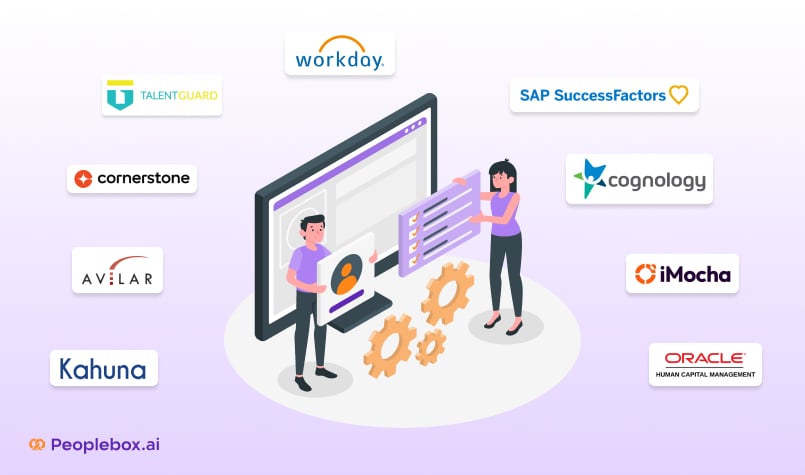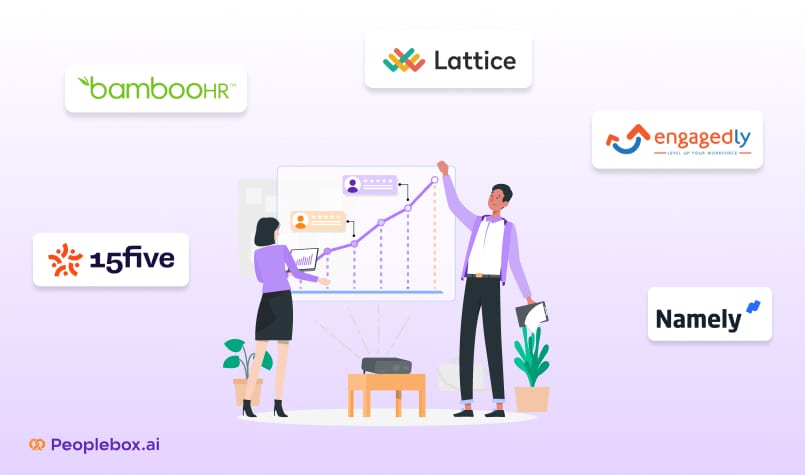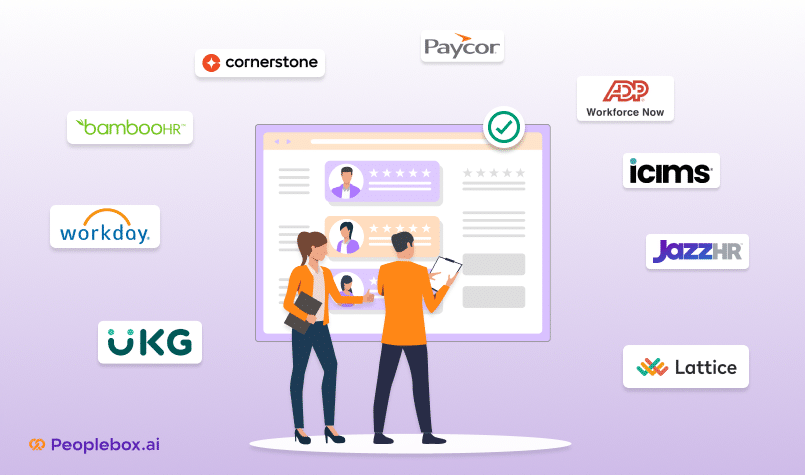Here is the truth: If you want to reduce employee turnover and increase productivity in your organization, you have to focus on employee engagement. There is no other way.
Today’s employees want to be wholly involved in their work and enthusiastic about the organization they work for. However, according to a survey, only 37% of executives strongly agree that engagement is a significant organizational focus.
Now, there are several ways to enhance employee engagement and give your employees a sense of belonging. One of them is following the Job Characteristics Model (JCM).
In this guide, we will discuss what this framework is all about and how you can use it to drive employee engagement.
Let’s get started!

🤔 What is the Job Characteristics Model?
The Job Characteristics Model is a framework to boost employee engagement in the workplace. It is also a widely used methodology for job analysis and job design research. According to this model, an employee’s motivation and satisfaction can be improved if the following five core job characteristics are present in the role:

Jobs with these five characteristics tend to be highly motivating and satisfying for employees. Ultimately, this leads to increased productivity and lower turnover rates.
JCM was developed in the mid-1970s by Greg Oldham and Richard Hackman, two organizational psychologists who wanted to understand why employees lose interest in their jobs. They spent a lot of time studying workers and came up with this comprehensive job characteristics theory. Interestingly, even after 40 years, this model is still relevant in our workplace.
🖐️ What are the Five Core Job Characteristics?
Let us now understand in detail the five core work characteristics that form the core of the JCM model.
☝️ Skill Variety

It is the degree to which a job requires variety. This could be a variety of activities performed or even the skills that need to be applied in day-to-day operations. When the skill variety is high in a job, it challenges the employees to use a range of capabilities. This ultimately impacts internal work motivation and employee satisfaction.
For instance, a graphic designer job requires a high level of skill variety as they need to apply different skills, including creativity, software proficiency, communication with other team members, problem-solving, etc.
However, an assembly line worker will have limited skill variety as they need to perform the same repetitive task over and over, like attaching the same part to a product, without much variation in activities or skills.
✌️ Task Identity

It is the degree to which a job requires completing a whole and identifiable piece of work. In simple words, when the task identity is high in a job, the employee will be able to see a task through from beginning to end.
This provides a sense of accomplishment and ownership over the outcome.
For instance, a software developer exemplifies high task identity. They manage the entire lifecycle of a project, from gathering requirements and designing the application to coding, testing, and deploying it.
In contrast, a data entry clerk typically has a lower task identity, as they only handle specific parts of the data entry process without seeing the overall project outcome.
👌 Task Significance

It is the degree to which a job has an impact on stakeholders, both inside and outside the organization. A job with high task significance means an employee’s work has a meaningful effect on others’ lives or well-being.
For instance, a Chief Executive Officer’s work impacts the whole organization and is of high significance. Their decisions will have a direct impact on the profitability of the organization, which, in turn, can determine salary hikes for employees or the need to trim down the workforce.
However, a data entry clerk will have limited task significance as their impact is often indirect and may not be immediately perceived as significantly affecting other people’s lives or the broader mission of the organization.
🖖 Autonomy

It is the level of independence employees have in scheduling their work or in determining the modus operandi of specific tasks. Jobs with high autonomy empowers employees to take ownership of their tasks.
For instance, a remote content writer has control over how, when, and where they work. They also have a high degree of independence in terms of how the article will shape up, the tone of the article, what details to include, etc. However, a call center agent often will have a strict script and procedure to follow, with little flexibility in how they perform their job.
✋ Feedback

It is the degree to which an employee has clear and direct information about their effectiveness and performance. When employees receive regular, constructive feedback, they can adjust their work accordingly and feel a sense of progress in their jobs.
A sales rep often receives immediate feedback through sales results and customer interactions. This allows them to understand how well they are performing.
On the other hand, a research scientist’s job fares poorly in this area as the results of experiments or projects may take a long time to become apparent. Feedback on their work can be delayed, often making it hard to gauge the effectiveness of their work.
| Job Characteristic | High-Value Jobs | Low-Value Jobs |
| Skill Variety | Software Engineer, Product Manager, UX Designer | Data Entry Clerk, Bug Tester, Support Agent |
| Task Identity | Full-Stack Developer, SaaS Product Owner, DevOps Engineer | Help Desk Technician, QA Tester, Maintenance Worker |
| Task Significance | Cybersecurity Analyst, Cloud Architect, Data Scientist | IT Support Specialist, System Administrator, Junior Tester |
| Autonomy | Software Architect, Freelance Developer, SaaS Consultant | Call Center Operator, Junior Support Technician, Assembly Line Worker |
| Feedback | Agile Coach, Tech Lead, Customer Success Manager | Entry-Level Programmer, Manual Tester, Data Processor |
How Does the Job Characteristics Model Work?
While the five characteristics lead to improved motivation and employee engagement, there is a key aspect of the model that needs to be highlighted — Employee’s ‘Psychological States’ that sits right in between the characteristics and the outcomes.
According to the original JCM model, the five job characteristics directly lead to the following critical psychological states of the employees:
Experienced meaningfulness of the work
This psychological state emerges from skill variety, task identity, and task significance characteristics. When employees feel their work is varied, whole, and significant, they are more likely to find it meaningful. They start believing that they accomplished something of value, which will drive meaningfulness.
Experienced responsibility for outcomes
This psychological state emerges from the autonomy characteristic. When employees feel they have full control over their work, they have a sense of ownership over their tasks. In other words, they feel responsible for their successes or failures.
Knowledge of the actual results of the work activities.
This psychological state emerges from the feedback characteristic. When the employees see the consequences of their job via feedback, they will stay motivated and will be able to better assess their work performance and adjust accordingly. This invariably closes the loop between action and awareness of results.
What are the Benefits of Using the Job Characteristics Model?
Here are some of the key benefits you can enjoy by designing jobs around the JCM model:
👉 Increased employee motivation and satisfaction
This is the most obvious benefit and the core reason for developing the JCM model. Jobs designed around JCM make employees feel valued. They start finding their work meaningful, which leads to higher levels of motivation. They also have a strong emotional connect to their work, which reduces burnout or stress. All of these contribute to a healthier work environment.
👉 Reduced turnover and absenteeism
When employees feel challenged and in control of their work, they are less likely to leave the organization. Jobs designed based on JCM easily satisfy employees’ psychological and emotional needs, automatically building a long-term commitment to the organization. Higher job satisfaction due to interesting jobs also leads to fewer instances of absenteeism.
This is because employees are more motivated to come to work. For instance, a satisfied employee is less likely to call in sick due to job dissatisfaction.
👉 Enhanced productivity and performance
Jobs designed around JCM encourage employees to take ownership of their tasks. They also promote the use of all their skills, which leads to improved quality of work and motivates employees to perform at their best every time.
Also, when employees receive regular feedback on their performance, they can swiftly make adjustments and improve their output. One of the JCM characteristics—autonomy—empowers employees to find more efficient ways of doing their regular job.
👉 Better alignment with organizational goals
While designing jobs according to the JCM framework, you can tailor them so that employees are also working towards organizational goals. Employees are apprised of the significance of their work towards organizational goals, which will give them a sense of responsibility for the success of the organization. Ultimately, you will build a workforce where individual job satisfaction and organizational objectives go hand in hand.
Now that we’ve seen the basics, let’s look at how you can apply JCM at your workplace.
⚙️ How to Apply the Job Characteristics Model?
Here is a step-by-step guide on how to implement JCM in your organization:

Step 1: Understand the existing job design
Learn everything about the current team’s job roles and responsibilities. Evaluate how much they align with the five core job characteristics.
The ultimate goal of this step is to ensure you know the current state of the job or work design within your organization. This will provide a solid foundation for applying the JCM model.
Step 2: Identify opportunities for improvement
Compare each role’s different characteristics to find specific areas that can be enhanced. For example, you may discover that employees are underutilizing their skills. Offering more varied responsibilities could address this.
Similarly, task significance can be improved in some roles by clarifying how an employee’s work impacts the organization. Or you could give them more ownership of tasks from start to finish.
Step 3: Involve employees in the redesign process
The employees’ input is always crucial in the JCM model. After all, they are the ones directly affected by these changes. Involve the employees in the job redesign process via surveys, focus groups, or individual interviews. You will certainly gain valuable insights into what improvements would most benefit them.
This will also make the employees feel more involved in shaping their roles and responsibilities.
Step 4: Implement incremental changes
Don’t go ahead and make sweeping adjustments all at once. Start with small, manageable changes to test their impact. Phased rollouts allow you to monitor progress and make necessary adjustments.
Regularly check in with employees to evaluate how the changes have affected their motivation and satisfaction. This will make sure that improvements align with organizational goals and employee needs.
🤔 What are the Key Challenges in Applying the Job Characteristics Model?
There are three challenges you may typically encounter while applying the JCM model in your organization
Resistance to change
Your employees might be accustomed to their current roles and workflows even if their jobs are unfulfilling or poorly designed. They may feel secure and be uncomfortable with changes.
This is particularly applicable when they have to learn new skills or take on additional responsibilities. Autonomy and accountability are often perceived as added pressure by employees.
Interestingly, even managers might resist changes as they believe by giving more autonomy; they might lose control over the process or, worse, feel they will be replaced in the long run. Such factors could lead to pushback from all sides.
To avoid such a situation, involve employees early in the job redesign process. Clearly communicate the benefits and offer training to help employees adjust. Open dialogue and addressing concerns can ease the transition and build buy-in.
Cost of redesigning jobs
Redesigning jobs to include the core characteristics of the JCM is not simple. It can be time-consuming and resource-intensive, especially for large organizations. For instance, redesigning jobs often requires training employees to perform the new tasks.
And training programs require financial investment and time away from day-to-day work for employees. Sometimes, training might require external expertise, which can burn a significant hole in the company’s pockets.
The best way to manage costs is by prioritizing roles that would benefit most from job redesign. Also, try to make changes incrementally. If possible, try relying on the expertise of cross-functional teams for redesigning jobs instead of expensive external consultants.
Difficulty in measuring impact
Measuring the impact of job enrichment is not a simple qualitative calculation. We know that JCM has established strong relationships between job characteristics and psychological states and positive work outcomes like motivation and job satisfaction. Quantifying such elements in a clear and consistent way is not easy because they are subjective and can vary significantly from person to person.
Also, the benefits of job redesign may not be immediately apparent. It may take months for employees to adjust to their new roles, for satisfaction to materialize, and for performance to show visible enhancement. This delay can make it difficult for you to assess the immediate impact of job redesign.
To make matters worse, it is also not easy to pinpoint the actual cause of performance improvement. Factors such as better leadership or external market conditions can also impact performance. Put simply, isolating the effect of job redesign from other variables is often challenging.
Conducting regular employee pulse surveys and detailed feedback sessions is the most effective way to evaluate the impact of job redesign.
How can Peoplebox help you apply JCM in your organization?
Peoplebox is the only tool you would need for implementing the JCM framework in your organization.
By leveraging Peoplbox’s goal-setting feature, you can improve the task identity characteristic of a role. Clear and well-defined goals that align with organizational objectives give a sense of ownership and a strong connection to their tasks.

Such goals will enable the employees to complete an identifiable piece of work from start to finish. More importantly, it will allow them to see how their efforts contribute to a larger outcome.
Similarly, Peoplebox’s real-time analytics provide insights that help improve skill variety and task significance. The insights generated around employee performance can empower managers to make their roles more challenging and meaningful.
It can also pinpoint areas where employees’ skills are underutilized and where additional responsibilities or variety can be introduced to keep work engaging.
Finally, Peoplebox’s capabilities in facilitating continuous feedback and one-on-one meetings help improve the feedback and autonomy characteristics. By giving a strong voice to the employees, Peoplebox gives employees greater control over their work and development.
Peoplebox even supports open communication between managers and employees through its integration with Slack and Teams, ensuring that this is no misinformation or misunderstandings regarding changes to roles and responsibilities.
Long story short, with Peoplebox, the implementation of JCM principles becomes more structured and data-driven, leading to a more engaged and satisfied workforce with minimal effort.Want to see Peoplebox in action? Get in touch with us today!







